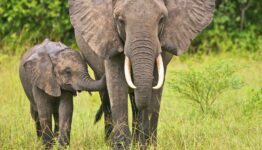
Humans and animals will overlap on nearly 57% of Earth by 2070
The overlap between humans and animals will increase substantially across much of the planet in less than 50 years due to human population growth and climate change, according to a new study.
By 2070, the overlap between humans and more than 22,000 vertebrate species will rise across nearly 57% of Earth’s land, according to the researchers.
“This gives us an early warning of where we may expect to see future increases in habitat degradation, human-wildlife conflict, or biodiversity loss,” says coauthor Briana Abrahms, a University of Washington assistant professor of biology in the Center for Ecosystem Sentinels.
“We especially need to pay attention to forested areas, which is where we project much of the increase in human-wildlife overlap to occur.”
In contrast, less than 12% of land globally will see a decrease in habitat sharing between people and other animals.
Understanding where the overlap is likely to occur—and which animals are likely to interact with humans in specific areas—will help urban planners, conservationists, and countries meet their international conservation commitments.
To calculate future human-wildlife overlap, the researchers created an index that combined estimates of where people are likely to live with the spatial distributions of 22,374 species of land-based amphibians, reptiles, birds, and mammals.
“The index we created showed that the majority of global lands will experience increases in human-wildlife overlap, and this increasing overlap is the result of the expansion of human population much more so than changes in species distributions caused by climate change,” says lead author Deqiang Ma, a postdoctoral researcher at the University of Michigan.
For the index, they drew information about the spatial distribution of vertebrates from previously published data, which also forecasts where species will live based on their ecological and climactic niches. Their estimates of where people are likely to live were based on projections of economic development, global society, and demographics.
“In many places around the world, more people will interact with wildlife in the coming decades, and often those wildlife communities will comprise different kinds of animals than the ones that live there now,” says senior author Neil Carter, an associate professor of environment and sustainability at the University of Michigan.
“This means that all sorts of novel interactions, good and bad, between people and wildlife will emerge in the near future.”
The researchers found that areas that have high levels of human-wildlife overlap today—and are predicted to see high overlap in 2070—are largely concentrated in regions where human population density is already high, including China and India.
In addition, they project that human-wildlife overlap will increase in forested areas, particularly in Africa and South America, two continents with high levels of biodiversity threatened by human activity. They predict that median species richness—the variety of species in a given area—will decrease across most forests on both continents.
But preserving biodiversity has real benefits, according to the study. For example, part of their analysis, which was led by Ma, looked at birds that eat insects in agricultural areas and examined where those birds will go under climate change. They found that more than two-thirds of the croplands that will likely experience an increase of human-wildlife overlap by 2070 will see a decline in bird species that can help reduce crop pests.
Studies have also shown that scavengers such as vultures and hyenas play critical roles by clearing waste from urban areas and other landscapes, which reduces the prevalence of rabies, anthrax, bovine tuberculosis, and other diseases.
“This research can help us identify which human communities, wildlife species, and geographies are likely to feel the compounded effects of future societal and environmental changes,” says Abrahms.
“For example, not only will certain human communities have to contend with the direct stressors of climate change, but they will also have to contend with shifting human-wildlife interactions as a result. The same is true for wildlife communities.”
Future conservation strategies will have to evolve, especially in regions that previously haven’t seen much human settlement, according to the researchers. In the past, a core conservation strategy was to establish protected areas where human access is restricted. This is becoming harder to implement because there are fewer such places.
“There’s also a significant environmental justice argument around the validity of telling communities that may have lived in a certain area for generations that they have to move,” says Carter.
“Our study suggests that with more areas of the world expected to be shared both by people and wildlife, conservation planning will have to get more creative and inclusive.”
Conservationists will need to engage local communities to build interest in helping improve the conservation process. This process may include establishing habitat corridors to connect protected areas or other conservation innovations, such as establishing temporary protected areas during critical periods for wildlife, like breeding seasons.
“We care a lot about which areas can support populations of endangered species, like tigers, and how human communities interact with these species,” says Carter.
“In some places it’s going to be really hard to do everything at once: to grow crops and have urban areas and protect these species and their habitats. But if we can start planning now, we have a lot of tools to help us promote sustainable coexistence.”
The study appears in Science Advances.
Additional coauthors are from the University of Michigan and University College London.
Funding for the research came from the University of Michigan, the David and Lucile Packard Foundation, and the Royal Society.
This story was adapted from a press release by the University of Michigan.
Source: University of Washington



